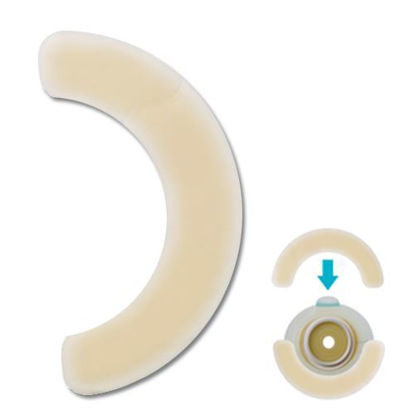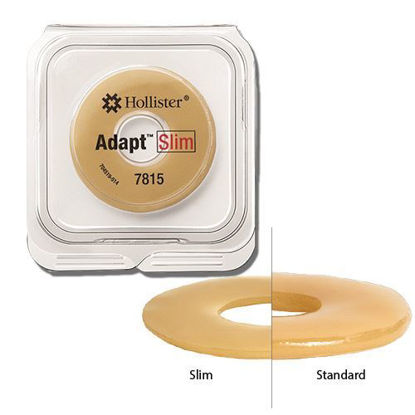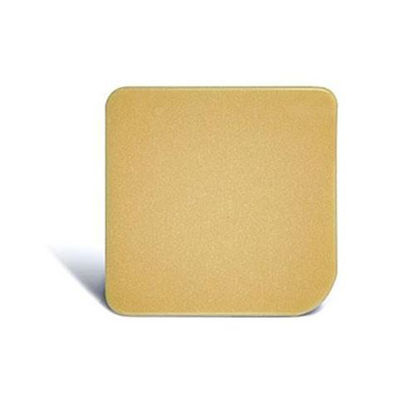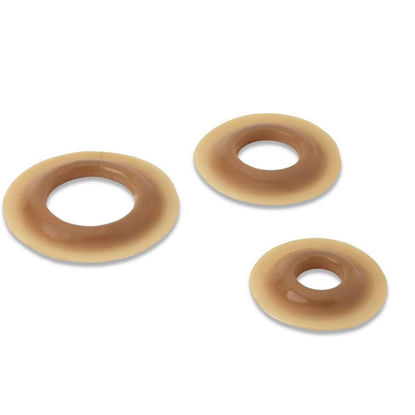- Brands
- Blog
- About Us
- Contact
- Daily Living Aids
- Catheters
- Compression Stockings & Socks
- Medical Cushions for Seating & Bedding
- Medical Incontinence Supplies
- Infection Control Supplies
- Ostomy Supplies
- Personal Care Medical Supplies
- Respiratory Care
- Wheelchairs & Accessories
- Wound Care Supplies
Ostomy barrier rings and seals are designed to prevent ostomy leaks and protect the stomal skin. They are placed underneath your ostomy wafer to fill in any gaps between your stoma and the wafer.
The flexible material makes it easy to mold the seals around your stoma. The process of shaping the product up the length of your stoma is also known as "turtle necking". Doing so provides a more snug fit around your stoma.
Stoma Barrier Rings
Barrier rings are circular in shape with a round hole already cut out of the center. These work best for individuals who have a uniform-shaped stoma.
Barrier seals are solid sheets with no holes or cut outs. This allows you to cut whatever shape or size hole you need, making them ideal for people with an irregular-shaped stoma. You can also stretch and layer either of these products for the perfect fit.
Barrier Strips
Express Medical Supply also carries barrier strips. These are made from the same material as barrier rings and seals, but they are placed on top of your ostomy wafer around the edges to provide additional security.
Barrier strips, also called barrier extenders, ensure that the outer edges of your ostomy wafer will not roll up away from the skin. Barrier strips work similarly to medical tape, but are more versatile. They are available in straight and curved shapes, as well as various widths to suit your needs.
Moldable Ostomy Wafers
A moldable ostomy appliance is an innovative product. It eliminates the need to use a separate barrier ring because it has the same flexible material already built into the flange. If you enjoy the benefits of using a barrier ring but don't like the extra steps involved, a moldable ostomy wafer is ideal.
It cuts down on the amount of steps you have to take in order to change your pouch. This can be more convenient if you are in a public restroom or need to quickly change your pouch.
Moldable ostomy wafers are available in pre-cut and cut-to-fit styles, although scissors are not required because you can simply roll the material back when applying your wafer.
Stoma Paste
Another helpful product for ostomates is stoma paste. This product serves the same purpose as barrier rings and stoma seals, but is more of a caulk-like consistency that comes in a squeeze tube. It fills in any divots or folds in the skin near the stoma.
Creating a flat surface reduces the risk of leaks, allows your barrier to adhere to your body better, and can even help your wafer wear for a longer period of time.
Coloplast Brava makes a unique type of stoma paste that is in the form of pliable strips. The strip paste is more of a solid consistency, making it a bit less messy than traditional ostomy paste. Please see our ostomy blog for tips on how to apply stoma paste.
Skin Care
If the skin around your stoma is raw or weepy, it can be difficult to get your wafer to stick to your body.
Stoma powder is designed to alleviate this problem. It is meant to absorb moisture from broken skin. When the powder comes into contact with moisture, it forms a gel. This improves barrier adhesion while also protecting the broken skin. Applying a thin layer of stoma powder will yield the best results.
Keep in mind, baby powder or any other type of body powder is not a substitute for stoma powder.
We carry several different ostomy powders from brands like Coloplast Brava and Hollister Adapt. Stoma powder is only meant to be used on weepy or raw skin. If your stomal skin is in healthy condition, stoma powder will not provide any benefit.
You can use a skin prep product in combination with stoma powder to perform the "crusting" technique. Adding skin prep on top locks the powder in place, increasing its effectiveness.
After applying the powder, you simply dab the area with a skin prep wipe or spray a light layer of liquid skin prep to the affected area. Skin prep can also be used on its own without stoma powder to form a protective barrier around the stomal area.
No matter how you use skin prep solutions, be sure to let the formula completely dry before applying your ostomy wafer.
Ostomy Pouching System
When it comes time to change your ostomy pouch, removing the wafer can be difficult due to its strong adhesive. Applying an adhesive remover for skin during the process will make it much easier and more comfortable.
This product gently breaks down the glue without causing irritation. Once the barrier is off of your body, you can apply additional adhesive remover to eliminate any residue that may be left behind. This will create a clean surface for your next barrier to adhere to, helping it stay secure and wear longer.
Ostomy Barrier Rings FAQs
What are ostomy barrier rings made of?Barrier rings are made from a hydrocolloid material. This material makes them moldable and flexible, allowing you to customize the fit.
How close should the barrier ring be to the stoma?
The barrier ring should sit right up against the stoma. If there is any space between your stoma and the barrier ring, output can get under the pouch seal or come into contact with the stoma and cause irritation.
How do you use a convex barrier ring?
Remove the backing from both sides of the ring. You can then stretch the ring as desired. Apply the flat side of the ring to your ostomy wafer. Then apply your ostomy system as norml. The curved part of the ring will sit against your skin.
What is a stoma seal?
A stoma seal is another term for a barrier ring. There are square or rectanglar shaped stoma seals that are made from the same material as rings, but do not have a hole. These are referred to as stoma seals since they are not ring-shaped.
What will happen if you apply lotion around the stoma?
Using regular body lotion on or aound the stoma can cause irritation, especially if it contains fragrance or alcohol. Lotion can also prevent your ostomy pouch from sticking to your skin.
How do you treat raw skin?
Raw peristomal skin should be specially cared for. The crusting technique can be performed, which involves applying stoma powder to the area and then sealing it in place with a skin barrier wipe or spray. It helps shield irritated skin by forming a protective layer over the area. If you are experiencing severe irritation or if it worsens, contact your ostomy nurse as soon as possible.
Coloplast Brava - Curved Elastic Barrier Strips
- Prevents ostomy leaks
- Unique material absorbs moisture
- Curved shape wraps around the ostomy wafer
- 5 1/2" x 1 1/4"
- Box of 20
Hollister Adapt - Slim Ostomy Barrier Ring
- Box of 10
- 2.3 mm thick
- Moldable latex free material
- Protects stomal skin from output
- Creates a flat surface
ConvaTec Eakin - Rectangle Stoma Seal
- Absorbs moisture for a better seal
- Protects stomal skin from contact with output by absorbing excess moisture
- This product works with flush and retracted stomas
- Skin friendly
- Forms a gel that helps protect skin
- 4" x 8" large rectangle
ConvaTec Eakin - Square Stoma Seal
- Moldable and moisture absorbing
- Protects stomal skin from contact with output
- Can be used with flush and retracted stomas
- Skin friendly
- 4" x 4" small square, box of 5
Hollister CeraRing Round Convex Barrier Rings
Hollister CeraRing Round Convex Barrier Rings
Product Features:
- Convexity Infused with ceramide
- Round convex; Flextend material with ceramide
- Flexible and moldable
- Not made with natural rubber latex
- Available in multiple sizes
- Each box contains 10 barrier rings
Ostomy barrier rings and seals are designed to prevent ostomy leaks and protect the stomal skin. They are placed underneath your ostomy wafer to fill in any gaps between your stoma and the wafer.
The flexible material makes it easy to mold the seals around your stoma. The process of shaping the product up the length of your stoma is also known as "turtle necking". Doing so provides a more snug fit around your stoma.
Stoma Barrier Rings
Barrier rings are circular in shape with a round hole already cut out of the center. These work best for individuals who have a uniform-shaped stoma.
Barrier seals are solid sheets with no holes or cut outs. This allows you to cut whatever shape or size hole you need, making them ideal for people with an irregular-shaped stoma. You can also stretch and layer either of these products for the perfect fit.
Barrier Strips
Express Medical Supply also carries barrier strips. These are made from the same material as barrier rings and seals, but they are placed on top of your ostomy wafer around the edges to provide additional security.
Barrier strips, also called barrier extenders, ensure that the outer edges of your ostomy wafer will not roll up away from the skin. Barrier strips work similarly to medical tape, but are more versatile. They are available in straight and curved shapes, as well as various widths to suit your needs.
Moldable Ostomy Wafers
A moldable ostomy appliance is an innovative product. It eliminates the need to use a separate barrier ring because it has the same flexible material already built into the flange. If you enjoy the benefits of using a barrier ring but don't like the extra steps involved, a moldable ostomy wafer is ideal.
It cuts down on the amount of steps you have to take in order to change your pouch. This can be more convenient if you are in a public restroom or need to quickly change your pouch.
Moldable ostomy wafers are available in pre-cut and cut-to-fit styles, although scissors are not required because you can simply roll the material back when applying your wafer.
Stoma Paste
Another helpful product for ostomates is stoma paste. This product serves the same purpose as barrier rings and stoma seals, but is more of a caulk-like consistency that comes in a squeeze tube. It fills in any divots or folds in the skin near the stoma.
Creating a flat surface reduces the risk of leaks, allows your barrier to adhere to your body better, and can even help your wafer wear for a longer period of time.
Coloplast Brava makes a unique type of stoma paste that is in the form of pliable strips. The strip paste is more of a solid consistency, making it a bit less messy than traditional ostomy paste. Please see our ostomy blog for tips on how to apply stoma paste.
Skin Care
If the skin around your stoma is raw or weepy, it can be difficult to get your wafer to stick to your body.
Stoma powder is designed to alleviate this problem. It is meant to absorb moisture from broken skin. When the powder comes into contact with moisture, it forms a gel. This improves barrier adhesion while also protecting the broken skin. Applying a thin layer of stoma powder will yield the best results.
Keep in mind, baby powder or any other type of body powder is not a substitute for stoma powder.
We carry several different ostomy powders from brands like Coloplast Brava and Hollister Adapt. Stoma powder is only meant to be used on weepy or raw skin. If your stomal skin is in healthy condition, stoma powder will not provide any benefit.
You can use a skin prep product in combination with stoma powder to perform the "crusting" technique. Adding skin prep on top locks the powder in place, increasing its effectiveness.
After applying the powder, you simply dab the area with a skin prep wipe or spray a light layer of liquid skin prep to the affected area. Skin prep can also be used on its own without stoma powder to form a protective barrier around the stomal area.
No matter how you use skin prep solutions, be sure to let the formula completely dry before applying your ostomy wafer.
Ostomy Pouching System
When it comes time to change your ostomy pouch, removing the wafer can be difficult due to its strong adhesive. Applying an adhesive remover for skin during the process will make it much easier and more comfortable.
This product gently breaks down the glue without causing irritation. Once the barrier is off of your body, you can apply additional adhesive remover to eliminate any residue that may be left behind. This will create a clean surface for your next barrier to adhere to, helping it stay secure and wear longer.
Ostomy Barrier Rings FAQs
What are ostomy barrier rings made of?Barrier rings are made from a hydrocolloid material. This material makes them moldable and flexible, allowing you to customize the fit.
How close should the barrier ring be to the stoma?
The barrier ring should sit right up against the stoma. If there is any space between your stoma and the barrier ring, output can get under the pouch seal or come into contact with the stoma and cause irritation.
How do you use a convex barrier ring?
Remove the backing from both sides of the ring. You can then stretch the ring as desired. Apply the flat side of the ring to your ostomy wafer. Then apply your ostomy system as norml. The curved part of the ring will sit against your skin.
What is a stoma seal?
A stoma seal is another term for a barrier ring. There are square or rectanglar shaped stoma seals that are made from the same material as rings, but do not have a hole. These are referred to as stoma seals since they are not ring-shaped.
What will happen if you apply lotion around the stoma?
Using regular body lotion on or aound the stoma can cause irritation, especially if it contains fragrance or alcohol. Lotion can also prevent your ostomy pouch from sticking to your skin.
How do you treat raw skin?
Raw peristomal skin should be specially cared for. The crusting technique can be performed, which involves applying stoma powder to the area and then sealing it in place with a skin barrier wipe or spray. It helps shield irritated skin by forming a protective layer over the area. If you are experiencing severe irritation or if it worsens, contact your ostomy nurse as soon as possible.








